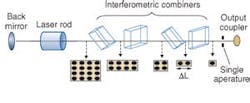LASER OPTICS: Sixteen laser beams combined with 88% efficiency
Many techniques have been developed for the coherent addition of several low-power laser beams to produce a high-power laser with improved beam quality. These coherent-addition methods, however, were limited to fewer than eight laser beams. Researchers at the Weizmann Institute of Science (Rehovot, Israel) have now extended coherent beam addition to 16 Gaussian-beam laser distributions by inserting four interferometric beam combiners inside a laser resonator.1
In the experimental setup, a 70-cm-long plano-concave laser resonator with a large-diameter gain medium-a 9‑mm-diameter, 10-cm-long Nd:YAG rod with 1.1% doping-yields 16 separate channels. The rod is placed in a ceramic pump chamber and pumped at a pulse rate of 0.5 Hz. A 1.3-mm aperture is placed close to the concave output coupler, which has a radius of 1.5 m and 40% reflectivity at 1064 nm. The four interferometric combiners (two pairs) are placed inside the resonator (see figure). The thickness of each combiner in the first pair is 2 mm, while the thickness of each combiner in the second pair is 4 mm. The 16 laser distributions right after the gain medium are folded vertically after the first combiner to form eight distributions. These eight beams are then folded horizontally by the second combiner to form four distributions. Finally, the next pair of combiners is used to form a single output beam.
Because coherent addition and phase locking are only possible if all beam distributions to be combined have some common longitudinal modes, the researchers developed a configuration whereby the end mirrors of all channels are common and the interferometric combiners introduce an integer number n of ∆L path-length differences among channels. Restoring the length difference of n∆L ensures that common frequency bands exist equally in the coherent addition of a large number of channels. The configuration can be scaled such that introduction of N combiners in the resonator will combine 2N beams, with combining efficiency limited by the cumulative losses of the combiner’s coatings. The 2- and 4-mm-thick beam-combiner plates have a parallelism of better than 1 arcsec, with half of the front surfaces of the plates coated with a 50% beamsplitter layer and half of the back surfaces of the plates coated with a highly reflective layer. The remaining halves are antireflection coated; a thin-film polarizer and polarization rotator control the polarization state of the beams.
Analysis of the laser beam without insertion of the interferometric beam combiners showed that each of the 16 channels had an output power of 2.6 mJ and a beam quality M2 of 1.3. Careful insertion of the interferometric combiners within the cavity, aided by a spectrometer and power measurements, produced a single Gaussian beam with a power of 37 mJ (an 88% beam-combining efficiency) that retained the beam quality M2 of 1.3.
The researchers, lead by professors Asher A. Friesem and Nir Davidson, note that their technique is also applicable to coherent addition of high-order-mode lasers, multimode lasers, and even fiber lasers, in which beam combining in free space could significantly reduce fiber damage and nonlinear effects.
REFERENCE
1. V. Eckhouse et al., Opt. Lett. 31(3) 350 (Feb. 1, 2006).
About the Author

Gail Overton
Senior Editor (2004-2020)
Gail has more than 30 years of engineering, marketing, product management, and editorial experience in the photonics and optical communications industry. Before joining the staff at Laser Focus World in 2004, she held many product management and product marketing roles in the fiber-optics industry, most notably at Hughes (El Segundo, CA), GTE Labs (Waltham, MA), Corning (Corning, NY), Photon Kinetics (Beaverton, OR), and Newport Corporation (Irvine, CA). During her marketing career, Gail published articles in WDM Solutions and Sensors magazine and traveled internationally to conduct product and sales training. Gail received her BS degree in physics, with an emphasis in optics, from San Diego State University in San Diego, CA in May 1986.
